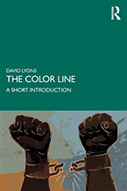The Color Line: A Short Introduction

Author: David Lyons
Publisher: New York: Routledge, 2019. 150p.
Reviewer: Bernard Boxill | February 2021
Americans generally see themselves as white, black, red, yellow, or brown. White Americans enjoy special status and privilege, the others do not. Naturally the latter try to share in the status and privilege of white Americans, but white Americans have built a color line to stop them. David Lyons’s new book, The Color Line: A Short Introduction shows how they did this. Spurred on by an ideology of white supremacy, they have seized every opportunity to bring down the other races. They sickened the Native Americans (red people) with European diseases, pushed them from their ancestral homelands, and then, well armed and in overwhelming numbers, drove the rapidly dwindling remainder westward into deserts and badlands. They enslaved African Americans (black people) for two centuries and then used segregation, discrimination, lynching, and terror to hold them down. They seized vast areas of Mexico and took advantage of the Latinos (brown people) they found there. They excluded Asian Americans (yellow people) from citizenship and confined the Japanese Americans to internment camps during the Second World War. And then having engrossed most of a continent, they annexed Hawaii, and attempted to establish an overseas empire at the expense of the darker peoples of the world, in the Philippines and the West Indies. Lyons’s concise review of so many deep injustices, committed as if to disavow the fundamental moral truths that European Americans had once proudly declared, is disturbing enough to tempt ruminations on the inconstancy and wickedness of human nature in general.
But Lyons’s accompanying account of the righteous struggles of Black, brown and white people against the color line actually vindicates human nature. Paying greatest but not exclusive attention to the struggles of Black people, he recounts the stubborn resistance of the slaves, their daring escapes to the North, the unceasing efforts of their descendants to maintain their self-respect, the valor of their struggles for civil rights, the steadfast morality of their sages and leaders, the deep insights of W.E. B. Du Bois, the militarism of Malcolm X, and the dream and civil disobedience of Martin Luther King Jr.
Lyons’s account of the creation of the color line indicates that whites used different methods to prevent the different non-white races from crossing or undoing the color line. It follows that these different non-white races have different histories that may, as he notes, ground different claims for reform or possible reparation. But he does not note that these different histories may also enable some of the non-white races to cross the color line before the others, or to put it another way, to become white, and leave the others behind in the lurch. Lyons’s comment on the “malleability” of the color line suggests that he is aware of this possibility, though probably for want of space he does not discuss the complications it leads to. But he does say enough to encourage his readers to continue where he left off, and certain of the books listed in the excellent bibliography he has provided suggest some of the ways they can do so. The book is provocative in many other ways, succinct, and immensely informative. Every American should study it.
Bernard Boxill, Professor of Philosophy, Emeritus. Department of Philosophy. University of North Carolina at Chapel Hill


